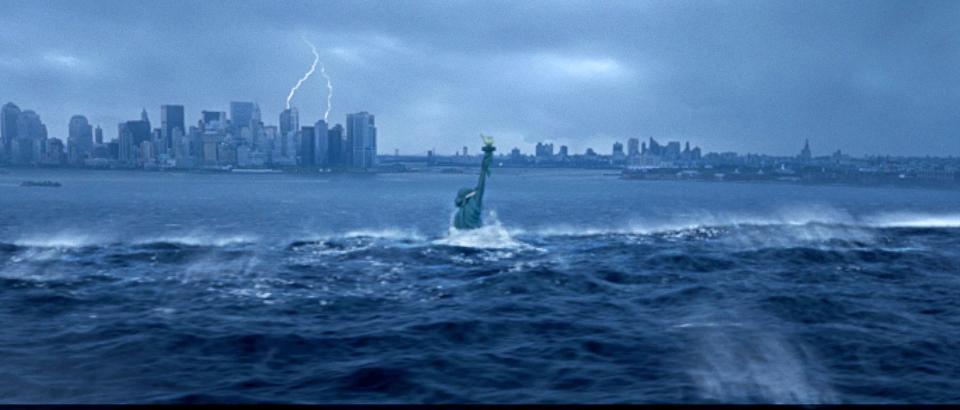Atlantic Ocean current could collapse soon. How you may endure dramatic weather changes.
Now this could be something to really worry about.
The Atlantic Meridional Overturning Circulation (AMOC) – a large system of ocean currents that carry warm water from the tropics into the North Atlantic – could collapse by the middle of the century, or possibly any time from 2025 onward, because of human-caused climate change, a study published Tuesday suggests.
Such a collapse could trigger rapid weather and climate changes in the U.S., Europe and elsewhere. If it were to happen, it could bring about an ice age in Europe and sea-level rise in cities such as Boston and New York, as well as more potent storms and hurricanes along the East Coast.
It also could lead to drastically reduced amounts of rain and snowfall across the central and western U.S., the study's authors say.
Earlier studies about the AMOC collapse drew comparisons to the scientifically inaccurate 2004 disaster movie "The Day After Tomorrow," which used such an ocean current shutdown as the premise of the film.
"We estimate a collapse of the AMOC to occur around mid-century under the current scenario of future emissions," the study authors write.
The AMOC collapse is one of several dangerous climate "tipping points" scientists say are possible because of climate change.

What is the AMOC?
“The Atlantic Meridional Overturning Circulation really is one of our planet’s key circulation systems,” said Niklas Boers from the Potsdam Institute for Climate Impact Research in Germany, the author of an earlier study on the topic.
The AMOC is a crucial conveyor belt for ocean water and air, which creates weather. Warm, salty water moves north from the tropics along the Gulf Stream off the U.S. East Coast to the North Atlantic, where it cools, sinks and heads south.
The faster it moves, the more water is turned over from warm surface to cool depths.
The cycle keeps northern Europe several degrees warmer than it would otherwise be and brings colder water to the coast of North America.
Studies in 2018 and 2021 have found that a collapse of the AMOC is possible at some point this century.
What's new in this study?
Using new statistical tools and ocean temperature data from the past 150 years, researchers calculated that the AMOC will stop – with 95% certainty – between 2025 and 2095. "Using new and improved statistical tools, we’ve made calculations that provide a more robust estimate of when a collapse is most likely to occur, something we had not been able to do before," said study co-author Susanne Ditlevsen, a professor at the University of Copenhagen.
The researchers' prediction is based on observations of early warning signals ocean currents exhibit as they become unstable.
The calculations contradict the message of the latest Intergovernmental Panel on Climate Change report, in which an abrupt change in the AMOC is considered "unlikely" this century.
"Our result underscores the importance of reducing global greenhouse gas emissions as soon as possible," said study co-author Peter Ditlevsen, also from the University of Copenhagen.
How could climate change cause the AMOC to collapse?
Study co-authors Peter and Susanne Ditlevsen explained to USA TODAY how the collapse of the AMOC could occur: "Greenhouse gas emissions cause global warming, which speeds up the melting of Greenland ice. The melted freshwater entering the North Atlantic can then disrupt the AMOC, potentially causing major climate disruptions.
"When the increased meltwater from Greenland enters the North Atlantic, it's freshwater, which is lighter than the salty seawater around it," the Ditlevsens said. "This excess freshwater can disrupt the normal sinking of the salty water, weakening or even shutting down the AMOC. If the AMOC collapses, it can have far-reaching effects on weather patterns and ocean currents, leading to significant climate changes."
What do others say?
Experts not involved in this study offer mixed reviews of its conclusions. Michael Mann, of the University of Pennsylvania, said, "I’m not sure the authors bring much to the table other than a fancy statistical method. History is littered with flawed predictions based on fancy statistical methods; sometimes they’re too fancy for their own good."
But Stefan Rahmstorf, a climate scientist at the Potsdam Institute for Climate Impact Research in Germany, told USA TODAY that "a single study provides limited evidence, but when multiple approaches lead to similar conclusions, this must be taken very seriously. Especially when we're talking about a risk that we really want to rule out with 99.9% certainty. The scientific evidence now is that we can't even rule out crossing a tipping point already in the next decade or two.
"There is still large uncertainty where the tipping point of the AMOC is, but the new study adds to the evidence that it is much closer than we thought just a few years ago."
The study was published Tuesday in the peer-reviewed British journal Nature Communications.
Contributing: The Associated Press; Elizabeth Weise, USA TODAY
This article originally appeared on USA TODAY: Is Atlantic Ocean current near collapse? Could be sooner than expected

